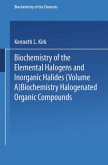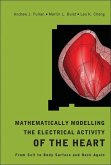Larbi El Mchichi, Mohammed Bouachrine, Tahar Lakhlifi
Anticancer Activity in Heterocyclic Organic Structures
A Pathway to Novel Drug Development Part 1
Larbi El Mchichi, Mohammed Bouachrine, Tahar Lakhlifi
Anticancer Activity in Heterocyclic Organic Structures
A Pathway to Novel Drug Development Part 1
- Gebundenes Buch
- Merkliste
- Auf die Merkliste
- Bewerten Bewerten
- Teilen
- Produkt teilen
- Produkterinnerung
- Produkterinnerung
This new volume in New Directions in Organic & Biological Chemistry, explores the development of cancer therapeutics, focusing on molecular chemistry and advanced drug design approaches.
Andere Kunden interessierten sich auch für
![Biochemistry of Halogenated Organic Compounds Biochemistry of Halogenated Organic Compounds]() Kenneth L. KirkBiochemistry of Halogenated Organic Compounds77,99 €
Kenneth L. KirkBiochemistry of Halogenated Organic Compounds77,99 €![The Purin Bodies of Food Stuffs, and the Rôle of Uric Acid in Health and Disease The Purin Bodies of Food Stuffs, and the Rôle of Uric Acid in Health and Disease]() Isaac Walker HallThe Purin Bodies of Food Stuffs, and the Rôle of Uric Acid in Health and Disease34,99 €
Isaac Walker HallThe Purin Bodies of Food Stuffs, and the Rôle of Uric Acid in Health and Disease34,99 €![Uric Acid Uric Acid]() Francis H. McCruddenUric Acid32,99 €
Francis H. McCruddenUric Acid32,99 €![Uric Acid: An Epitome of the Subject Uric Acid: An Epitome of the Subject]() Alexander HaigUric Acid: An Epitome of the Subject29,99 €
Alexander HaigUric Acid: An Epitome of the Subject29,99 €![Textbook of Personalized Medicine Textbook of Personalized Medicine]() Kewal K. JainTextbook of Personalized Medicine151,99 €
Kewal K. JainTextbook of Personalized Medicine151,99 €![Microbial Enzymes as Potential Biotherapeutics in Human Healthcare Microbial Enzymes as Potential Biotherapeutics in Human Healthcare]() Microbial Enzymes as Potential Biotherapeutics in Human Healthcare137,99 €
Microbial Enzymes as Potential Biotherapeutics in Human Healthcare137,99 €![Mathematically Modelling the Electrical Activity of the Heart: From Cell to Body Surface and Back Again Mathematically Modelling the Electrical Activity of the Heart: From Cell to Body Surface and Back Again]() Andrew PullanMathematically Modelling the Electrical Activity of the Heart: From Cell to Body Surface and Back Again118,99 €
Andrew PullanMathematically Modelling the Electrical Activity of the Heart: From Cell to Body Surface and Back Again118,99 €-
-
-
This new volume in New Directions in Organic & Biological Chemistry, explores the development of cancer therapeutics, focusing on molecular chemistry and advanced drug design approaches.
Produktdetails
- Produktdetails
- Verlag: CRC Press
- Seitenzahl: 166
- Erscheinungstermin: 23. Dezember 2025
- Englisch
- ISBN-13: 9781041100584
- ISBN-10: 1041100582
- Artikelnr.: 74244978
- Herstellerkennzeichnung
- Libri GmbH
- Europaallee 1
- 36244 Bad Hersfeld
- gpsr@libri.de
- Verlag: CRC Press
- Seitenzahl: 166
- Erscheinungstermin: 23. Dezember 2025
- Englisch
- ISBN-13: 9781041100584
- ISBN-10: 1041100582
- Artikelnr.: 74244978
- Herstellerkennzeichnung
- Libri GmbH
- Europaallee 1
- 36244 Bad Hersfeld
- gpsr@libri.de
Dr. Larbi EL Mchichi holds a PhD in Chemistry with a specialization in Theoretical Chemistry from Moulay Ismail University (Faculty of Sciences, Meknes). His doctoral research focused on the anticancer activity of heterocyclic organic molecules, using statistical and quantum methods, including QSAR modeling and molecular docking. In his research, Dr. EL Mchichi explores innovative computational approaches to the design of novel therapeutic agents, particularly anticancer compounds, utilizing techniques like 3D-QSAR, drug-likeness assessment, ADMET prediction, and molecular docking simulations. In addition to his research, he is a first-grade certified teacher of physics and chemistry at the secondary education level, where he strives to inspire his students with a passion for science and research. Dr. EL Mchichi has authored several peer-reviewed publications in international journals, including work on the design of pyrazole derivatives as anticancer agents and the discovery of a new isatin scaffold for BCR-ABL tyrosine kinase inhibitors. His research aims to contribute to the advancement of cutting-edge cancer therapies through the integration of computational methods and pharmaceutical science.
Preface. i Aknewlegment ii Author Biography. iii Table of Contents iii List of figure. viii Liste of Table. x General introduction. 1 Theoretical Part 5 Chapter 01 : Cancers and Anticancer Drugs 6 I..... Cancers 7 1. Definition. 7 2. Mechanisms of carcinogenesis 7 3. Characteristics of the cancer cell 8 II.... Cancer drugs 9 1. Mechanisms of Action. 9 2. Classification of anticancer agents according to their mechanism of action. 10 2.1. Drugs with a direct action on DNA. 10 a) Alkylating agents and derivatives 10 b) Platinum salts 12 2.2. Drugs with an indirect action on DNA. 12 a) Topoisomerase I and II inhibitors 12 2.3. Antimetabolite drugs. 14 2.4. Drugs targeting a specific receptor or mechanism in the tumor: Targeted therapy. 16 a) Monoclonal antibodies 17 b) Tyrosine kinase inhibitors (TKI) 20 c) Serine/threonine kinase inhibitors (STKI) 21 2.5. Drugs targeting certain hormones: Hormone therapy. 24 a) Hormone therapy for breast cancer. 25 b) Hormone therapy for prostate cancer. 27 2.6. Drugs targeting the immune system: Immunotherapy 29 III.. References 32 Chapter 02: In Silico Methods Used in the Design of New Anticancer Agents 34 I..... Introduction. 35 II.... Discovery of New Drugs 35 1. Development of tailor-made molecules 35 2. Identification and validation of targets 36 3. Generation of Hits and Leads 36 4. Lead optimization. 37 5. Clinical trials and commercialization. 37 III.. In Silico Screening Methods 38 1. Structure-based screening methods 39 2. Ligand-based screening methods ' ligand-based '. 39 IV.. ADMET Filtering. 40 1. Administration and absorption. 40 2. Lipinski's rules 40 3. Lead-like selection criteria. 42 4. Distribution. 43 5. Metabolism and excretion 43 6. Toxicology. 44 V.... Quantitative Structure-Activity Relationship (QSAR) Study. 44 1. Introduction. 44 2. History. 44 3. Definition. 45 4. Principle. 46 VI. 2D-QSAR.. 46 1. QSAR Tools and Methodology. 47 1.1. Biological parameters. 47 1.2. Molecular descriptors. 48 a) Types of descriptors 48 2. Descriptor selection and reduction. 53 3. Data modeling methods 53 a) Principal Component Analysis (PCA) 54 b) Multiple Linear Regression. 54 c) Nonlinear regression. 55 d) Artificial Neural Networks (ANN) 55 4. Model validation tools 57 a) R² coefficient 58 b) Fisher's test 58 c) Variance Inflation Factor (VIF) 59 d) Internal validation or cross-validation. 59 e) Mean Square Error (MSE) 60 f) Randomization test 61 g) External validation. 61 h) Applicability domain. 62 5. Creation of training and test datasets 63 6. Global strategy for QSAR studies 63 VII. 3D-QSAR.. 65 1. Comparative Molecular Field Analysis (CoMFA) 65 2. Comparative Molecular Similarity Index Analysis (CoMSIA) 66 3. Structure alignment 66 4. Calculation of molecular interaction fields in both CoMFA and CoMSIA.. 66 5. Graphical visualization of models 68 6. Prediction and extrapolation. 69 VIII. Molecular Docking. 69 1. Definition. 69 2. Docking Approches 70 2.1. Rigid Docking. 70 2.2. flexible Docking. 71 3. Ligand-receptor interaction. 71 3.1. Ionic bonds. 71 3.2. Hydrogen bonds. 71 3.3.
-
interactions. 72 3.4. Cation-
interactions. 72 3.5.
interactions. 72 3.6. Van der Waals interactions. 73 3.7. Hydrophobic effect 73 4. Molecular docking tools 73 4.1. Preparation and selection of receptors. 73 4.2. Main docking software. 74 5. Evaluation of docking methods 75 5.1. Re-docking. 75 5.2. Root Mean Square Deviation (RMSD) 75 X. Conclusion. 78 XI. References 79 Experimental Part 84 Chapter 03 : Study of the anticancer activity of heterocyclic organic molecules using the 2D QSAR method.. 85 Application 1: QSAR Study of New Compounds Based on 1, 2, 4-triazole as Potential Anticancer Agents 86 I..... Introduction. 88 II.... Material and Methods 88 1. Experimental Data. 88 2. Calculation of molecular descriptors. 90 3. Statistical analysis 90 III.. Results and Discussion. 92 1. Principal Components Analysis (PCA) 92 2. Multiple linear regressions (MLR) 96 3. Multiple nonlinear regressions (MNLR) 96 4. External validation. 97 5. Artificial Neural networks (ANN) 98 IV.. Conclusion. 100 V.... References 101 Chapter 04 : Study of the anticancer activity of heterocyclic organic molecules using the 3D-QSAR and Molecular Docking methods 107 Application 2 :3D-QSAR Study of the Chalcone Derivatives as Anti-cancer Agents 108 I..... Introduction. 110 II.... Materials and Methods 111 1. Computer simulations 111 2. Data set 111 3. Molecular Modeling. 113 4. Molecular Alignment 113 5. CoMFA and CoMSIA studies 114 6. Partial least square analysis 114 7. Validation of the models 114 8. Y-randomization test 115 9. Model acceptability criteria. 115 10. Lipinski's Rule and ADMET Prediction. 115 III.. Results and Discussion. 116 1. CoMFA statistical results 116 2. CoMSIA Statistical Results 116 3. Analysis of CoMFA and CoMSIA contour maps 119 3.1. CoMFA contour map. 119 3.2. CoMSIA contour map. 121 4. Y-randomization test 123 5. Design for new chalcone as anticancer agents 124 6. Lipinski's Rule and ADMET Prediction. 126 IV.. Conclusion. 127 V.... References 130 Application 3: In Silico Design of Novel Pyrazole derivatives containing thiourea skeleton as anti-cancer agents using: 3D QSAR, Drug-Likeness studies, ADMET Prediction and Molecular Docking. 131 I..... Introduction. 133 II.... Material and Methods 134 1. Computer simulations 134 1.1. Data set 134 1.2. Molecular alignment 137 2. CoMFA and CoMSIA studies 138 3. Partial least square analysis 138 4. Validation of the models 139 5. Y-randomization test 139 6. Model acceptability criteria. 139 7. Drug Likeness and ADMET Prediction. 140 8. Molecular Docking Study. 140 III.. Results and discussion. 140 1. Molecular alignment 140 2. CoMFA statistical results 141 3. CoMSIA Statistical Results 141 4. Y
randomization. 143 5. Contour analysis 144 5.1. CoMFA Contour map. 144 5.2. CoMSIA Contour maps 146 6. Design for new Pyrazole as anticancer agents 148 7. Drug-likeness studies 151 8. ADMET prediction. 153 9. Molecular docking study. 154 IV.. Conclusion. 156 V.... References 157 Application 4: Molecular Docking, Drug likeness Studies and ADMET prediction of Flavonoids as Platelet-Activating Factor (PAF) Receptor Binding. 161 I..... Introuduction. 163 II.... Material and Methods 165 1. Data collection. 165 1.1. Ligands 165 1.2. Receptor 165 2. Molecular Docking. 166 3. Docking validation protocol 167 4. Drug-likeness studies 167 5. ADMET prediction. 167 III.. Results and Discussion. 168 1. Molecular Docking. 168 2. Docking validation protocol 172 3. Drug-likeness studies 172 IV... Conclusion. 174 V.... References 174 General Conclusion. 175
-
interactions. 72 3.4. Cation-
interactions. 72 3.5.
interactions. 72 3.6. Van der Waals interactions. 73 3.7. Hydrophobic effect 73 4. Molecular docking tools 73 4.1. Preparation and selection of receptors. 73 4.2. Main docking software. 74 5. Evaluation of docking methods 75 5.1. Re-docking. 75 5.2. Root Mean Square Deviation (RMSD) 75 X. Conclusion. 78 XI. References 79 Experimental Part 84 Chapter 03 : Study of the anticancer activity of heterocyclic organic molecules using the 2D QSAR method.. 85 Application 1: QSAR Study of New Compounds Based on 1, 2, 4-triazole as Potential Anticancer Agents 86 I..... Introduction. 88 II.... Material and Methods 88 1. Experimental Data. 88 2. Calculation of molecular descriptors. 90 3. Statistical analysis 90 III.. Results and Discussion. 92 1. Principal Components Analysis (PCA) 92 2. Multiple linear regressions (MLR) 96 3. Multiple nonlinear regressions (MNLR) 96 4. External validation. 97 5. Artificial Neural networks (ANN) 98 IV.. Conclusion. 100 V.... References 101 Chapter 04 : Study of the anticancer activity of heterocyclic organic molecules using the 3D-QSAR and Molecular Docking methods 107 Application 2 :3D-QSAR Study of the Chalcone Derivatives as Anti-cancer Agents 108 I..... Introduction. 110 II.... Materials and Methods 111 1. Computer simulations 111 2. Data set 111 3. Molecular Modeling. 113 4. Molecular Alignment 113 5. CoMFA and CoMSIA studies 114 6. Partial least square analysis 114 7. Validation of the models 114 8. Y-randomization test 115 9. Model acceptability criteria. 115 10. Lipinski's Rule and ADMET Prediction. 115 III.. Results and Discussion. 116 1. CoMFA statistical results 116 2. CoMSIA Statistical Results 116 3. Analysis of CoMFA and CoMSIA contour maps 119 3.1. CoMFA contour map. 119 3.2. CoMSIA contour map. 121 4. Y-randomization test 123 5. Design for new chalcone as anticancer agents 124 6. Lipinski's Rule and ADMET Prediction. 126 IV.. Conclusion. 127 V.... References 130 Application 3: In Silico Design of Novel Pyrazole derivatives containing thiourea skeleton as anti-cancer agents using: 3D QSAR, Drug-Likeness studies, ADMET Prediction and Molecular Docking. 131 I..... Introduction. 133 II.... Material and Methods 134 1. Computer simulations 134 1.1. Data set 134 1.2. Molecular alignment 137 2. CoMFA and CoMSIA studies 138 3. Partial least square analysis 138 4. Validation of the models 139 5. Y-randomization test 139 6. Model acceptability criteria. 139 7. Drug Likeness and ADMET Prediction. 140 8. Molecular Docking Study. 140 III.. Results and discussion. 140 1. Molecular alignment 140 2. CoMFA statistical results 141 3. CoMSIA Statistical Results 141 4. Y
randomization. 143 5. Contour analysis 144 5.1. CoMFA Contour map. 144 5.2. CoMSIA Contour maps 146 6. Design for new Pyrazole as anticancer agents 148 7. Drug-likeness studies 151 8. ADMET prediction. 153 9. Molecular docking study. 154 IV.. Conclusion. 156 V.... References 157 Application 4: Molecular Docking, Drug likeness Studies and ADMET prediction of Flavonoids as Platelet-Activating Factor (PAF) Receptor Binding. 161 I..... Introuduction. 163 II.... Material and Methods 165 1. Data collection. 165 1.1. Ligands 165 1.2. Receptor 165 2. Molecular Docking. 166 3. Docking validation protocol 167 4. Drug-likeness studies 167 5. ADMET prediction. 167 III.. Results and Discussion. 168 1. Molecular Docking. 168 2. Docking validation protocol 172 3. Drug-likeness studies 172 IV... Conclusion. 174 V.... References 174 General Conclusion. 175
Preface. i Aknewlegment ii Author Biography. iii Table of Contents iii List of figure. viii Liste of Table. x General introduction. 1 Theoretical Part 5 Chapter 01 : Cancers and Anticancer Drugs 6 I..... Cancers 7 1. Definition. 7 2. Mechanisms of carcinogenesis 7 3. Characteristics of the cancer cell 8 II.... Cancer drugs 9 1. Mechanisms of Action. 9 2. Classification of anticancer agents according to their mechanism of action. 10 2.1. Drugs with a direct action on DNA. 10 a) Alkylating agents and derivatives 10 b) Platinum salts 12 2.2. Drugs with an indirect action on DNA. 12 a) Topoisomerase I and II inhibitors 12 2.3. Antimetabolite drugs. 14 2.4. Drugs targeting a specific receptor or mechanism in the tumor: Targeted therapy. 16 a) Monoclonal antibodies 17 b) Tyrosine kinase inhibitors (TKI) 20 c) Serine/threonine kinase inhibitors (STKI) 21 2.5. Drugs targeting certain hormones: Hormone therapy. 24 a) Hormone therapy for breast cancer. 25 b) Hormone therapy for prostate cancer. 27 2.6. Drugs targeting the immune system: Immunotherapy 29 III.. References 32 Chapter 02: In Silico Methods Used in the Design of New Anticancer Agents 34 I..... Introduction. 35 II.... Discovery of New Drugs 35 1. Development of tailor-made molecules 35 2. Identification and validation of targets 36 3. Generation of Hits and Leads 36 4. Lead optimization. 37 5. Clinical trials and commercialization. 37 III.. In Silico Screening Methods 38 1. Structure-based screening methods 39 2. Ligand-based screening methods ' ligand-based '. 39 IV.. ADMET Filtering. 40 1. Administration and absorption. 40 2. Lipinski's rules 40 3. Lead-like selection criteria. 42 4. Distribution. 43 5. Metabolism and excretion 43 6. Toxicology. 44 V.... Quantitative Structure-Activity Relationship (QSAR) Study. 44 1. Introduction. 44 2. History. 44 3. Definition. 45 4. Principle. 46 VI. 2D-QSAR.. 46 1. QSAR Tools and Methodology. 47 1.1. Biological parameters. 47 1.2. Molecular descriptors. 48 a) Types of descriptors 48 2. Descriptor selection and reduction. 53 3. Data modeling methods 53 a) Principal Component Analysis (PCA) 54 b) Multiple Linear Regression. 54 c) Nonlinear regression. 55 d) Artificial Neural Networks (ANN) 55 4. Model validation tools 57 a) R² coefficient 58 b) Fisher's test 58 c) Variance Inflation Factor (VIF) 59 d) Internal validation or cross-validation. 59 e) Mean Square Error (MSE) 60 f) Randomization test 61 g) External validation. 61 h) Applicability domain. 62 5. Creation of training and test datasets 63 6. Global strategy for QSAR studies 63 VII. 3D-QSAR.. 65 1. Comparative Molecular Field Analysis (CoMFA) 65 2. Comparative Molecular Similarity Index Analysis (CoMSIA) 66 3. Structure alignment 66 4. Calculation of molecular interaction fields in both CoMFA and CoMSIA.. 66 5. Graphical visualization of models 68 6. Prediction and extrapolation. 69 VIII. Molecular Docking. 69 1. Definition. 69 2. Docking Approches 70 2.1. Rigid Docking. 70 2.2. flexible Docking. 71 3. Ligand-receptor interaction. 71 3.1. Ionic bonds. 71 3.2. Hydrogen bonds. 71 3.3.
-
interactions. 72 3.4. Cation-
interactions. 72 3.5.
interactions. 72 3.6. Van der Waals interactions. 73 3.7. Hydrophobic effect 73 4. Molecular docking tools 73 4.1. Preparation and selection of receptors. 73 4.2. Main docking software. 74 5. Evaluation of docking methods 75 5.1. Re-docking. 75 5.2. Root Mean Square Deviation (RMSD) 75 X. Conclusion. 78 XI. References 79 Experimental Part 84 Chapter 03 : Study of the anticancer activity of heterocyclic organic molecules using the 2D QSAR method.. 85 Application 1: QSAR Study of New Compounds Based on 1, 2, 4-triazole as Potential Anticancer Agents 86 I..... Introduction. 88 II.... Material and Methods 88 1. Experimental Data. 88 2. Calculation of molecular descriptors. 90 3. Statistical analysis 90 III.. Results and Discussion. 92 1. Principal Components Analysis (PCA) 92 2. Multiple linear regressions (MLR) 96 3. Multiple nonlinear regressions (MNLR) 96 4. External validation. 97 5. Artificial Neural networks (ANN) 98 IV.. Conclusion. 100 V.... References 101 Chapter 04 : Study of the anticancer activity of heterocyclic organic molecules using the 3D-QSAR and Molecular Docking methods 107 Application 2 :3D-QSAR Study of the Chalcone Derivatives as Anti-cancer Agents 108 I..... Introduction. 110 II.... Materials and Methods 111 1. Computer simulations 111 2. Data set 111 3. Molecular Modeling. 113 4. Molecular Alignment 113 5. CoMFA and CoMSIA studies 114 6. Partial least square analysis 114 7. Validation of the models 114 8. Y-randomization test 115 9. Model acceptability criteria. 115 10. Lipinski's Rule and ADMET Prediction. 115 III.. Results and Discussion. 116 1. CoMFA statistical results 116 2. CoMSIA Statistical Results 116 3. Analysis of CoMFA and CoMSIA contour maps 119 3.1. CoMFA contour map. 119 3.2. CoMSIA contour map. 121 4. Y-randomization test 123 5. Design for new chalcone as anticancer agents 124 6. Lipinski's Rule and ADMET Prediction. 126 IV.. Conclusion. 127 V.... References 130 Application 3: In Silico Design of Novel Pyrazole derivatives containing thiourea skeleton as anti-cancer agents using: 3D QSAR, Drug-Likeness studies, ADMET Prediction and Molecular Docking. 131 I..... Introduction. 133 II.... Material and Methods 134 1. Computer simulations 134 1.1. Data set 134 1.2. Molecular alignment 137 2. CoMFA and CoMSIA studies 138 3. Partial least square analysis 138 4. Validation of the models 139 5. Y-randomization test 139 6. Model acceptability criteria. 139 7. Drug Likeness and ADMET Prediction. 140 8. Molecular Docking Study. 140 III.. Results and discussion. 140 1. Molecular alignment 140 2. CoMFA statistical results 141 3. CoMSIA Statistical Results 141 4. Y
randomization. 143 5. Contour analysis 144 5.1. CoMFA Contour map. 144 5.2. CoMSIA Contour maps 146 6. Design for new Pyrazole as anticancer agents 148 7. Drug-likeness studies 151 8. ADMET prediction. 153 9. Molecular docking study. 154 IV.. Conclusion. 156 V.... References 157 Application 4: Molecular Docking, Drug likeness Studies and ADMET prediction of Flavonoids as Platelet-Activating Factor (PAF) Receptor Binding. 161 I..... Introuduction. 163 II.... Material and Methods 165 1. Data collection. 165 1.1. Ligands 165 1.2. Receptor 165 2. Molecular Docking. 166 3. Docking validation protocol 167 4. Drug-likeness studies 167 5. ADMET prediction. 167 III.. Results and Discussion. 168 1. Molecular Docking. 168 2. Docking validation protocol 172 3. Drug-likeness studies 172 IV... Conclusion. 174 V.... References 174 General Conclusion. 175
-
interactions. 72 3.4. Cation-
interactions. 72 3.5.
interactions. 72 3.6. Van der Waals interactions. 73 3.7. Hydrophobic effect 73 4. Molecular docking tools 73 4.1. Preparation and selection of receptors. 73 4.2. Main docking software. 74 5. Evaluation of docking methods 75 5.1. Re-docking. 75 5.2. Root Mean Square Deviation (RMSD) 75 X. Conclusion. 78 XI. References 79 Experimental Part 84 Chapter 03 : Study of the anticancer activity of heterocyclic organic molecules using the 2D QSAR method.. 85 Application 1: QSAR Study of New Compounds Based on 1, 2, 4-triazole as Potential Anticancer Agents 86 I..... Introduction. 88 II.... Material and Methods 88 1. Experimental Data. 88 2. Calculation of molecular descriptors. 90 3. Statistical analysis 90 III.. Results and Discussion. 92 1. Principal Components Analysis (PCA) 92 2. Multiple linear regressions (MLR) 96 3. Multiple nonlinear regressions (MNLR) 96 4. External validation. 97 5. Artificial Neural networks (ANN) 98 IV.. Conclusion. 100 V.... References 101 Chapter 04 : Study of the anticancer activity of heterocyclic organic molecules using the 3D-QSAR and Molecular Docking methods 107 Application 2 :3D-QSAR Study of the Chalcone Derivatives as Anti-cancer Agents 108 I..... Introduction. 110 II.... Materials and Methods 111 1. Computer simulations 111 2. Data set 111 3. Molecular Modeling. 113 4. Molecular Alignment 113 5. CoMFA and CoMSIA studies 114 6. Partial least square analysis 114 7. Validation of the models 114 8. Y-randomization test 115 9. Model acceptability criteria. 115 10. Lipinski's Rule and ADMET Prediction. 115 III.. Results and Discussion. 116 1. CoMFA statistical results 116 2. CoMSIA Statistical Results 116 3. Analysis of CoMFA and CoMSIA contour maps 119 3.1. CoMFA contour map. 119 3.2. CoMSIA contour map. 121 4. Y-randomization test 123 5. Design for new chalcone as anticancer agents 124 6. Lipinski's Rule and ADMET Prediction. 126 IV.. Conclusion. 127 V.... References 130 Application 3: In Silico Design of Novel Pyrazole derivatives containing thiourea skeleton as anti-cancer agents using: 3D QSAR, Drug-Likeness studies, ADMET Prediction and Molecular Docking. 131 I..... Introduction. 133 II.... Material and Methods 134 1. Computer simulations 134 1.1. Data set 134 1.2. Molecular alignment 137 2. CoMFA and CoMSIA studies 138 3. Partial least square analysis 138 4. Validation of the models 139 5. Y-randomization test 139 6. Model acceptability criteria. 139 7. Drug Likeness and ADMET Prediction. 140 8. Molecular Docking Study. 140 III.. Results and discussion. 140 1. Molecular alignment 140 2. CoMFA statistical results 141 3. CoMSIA Statistical Results 141 4. Y
randomization. 143 5. Contour analysis 144 5.1. CoMFA Contour map. 144 5.2. CoMSIA Contour maps 146 6. Design for new Pyrazole as anticancer agents 148 7. Drug-likeness studies 151 8. ADMET prediction. 153 9. Molecular docking study. 154 IV.. Conclusion. 156 V.... References 157 Application 4: Molecular Docking, Drug likeness Studies and ADMET prediction of Flavonoids as Platelet-Activating Factor (PAF) Receptor Binding. 161 I..... Introuduction. 163 II.... Material and Methods 165 1. Data collection. 165 1.1. Ligands 165 1.2. Receptor 165 2. Molecular Docking. 166 3. Docking validation protocol 167 4. Drug-likeness studies 167 5. ADMET prediction. 167 III.. Results and Discussion. 168 1. Molecular Docking. 168 2. Docking validation protocol 172 3. Drug-likeness studies 172 IV... Conclusion. 174 V.... References 174 General Conclusion. 175








